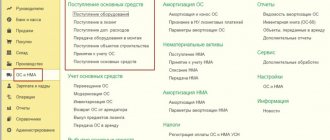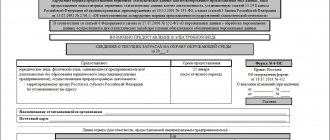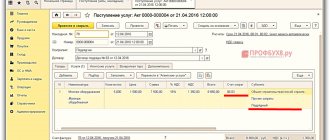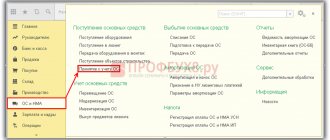Mandatory inventory is carried out to ensure the reliability of the data that will be used in drawing up the annual report. Thus, it is important to comply with the timing of its implementation. Mandatory inventory can be carried out by an organization only in the period from 01.10 to 31.12 of the year for which the report is being prepared.
The obligation for an organization to conduct an inventory of property capital is established by law. This is directly stated in Part 1 and Article 11 of Federal Law No. 402-FZ “On Accounting”. The same article determines that the procedure, timing and subject of inventory activities in relation to fixed assets, with the exception of mandatory inventory, are established by the organization independently.
Such inventories are carried out for various emerging circumstances that require determining the real condition of the property, including:
- Purchase, sale or lease of fixed assets;
- Legal transformation or liquidation of an organization;
- Transfer and acceptance of cases when changing persons who are assigned financial responsibility;
- Receipt of a signal about theft or damage to fixed assets, or other abuses;
- Various situations of force majeure or accident.
What is inventory?
Inventory is one of the procedures for monitoring the safety of company property.
Its essence is in comparing the actual availability of valuables (money, equipment, buildings, as well as liabilities) with accounting data. The procedure for conducting an inventory of fixed assets is regulated by the following legislative acts:
- methodological guidelines for inventory of property and financial obligations (Order of the Ministry of Finance dated June 13, 1995 No. 49);
- regulations on accounting and accounting in the Russian Federation (Order of the Ministry of Finance dated July 29, 1998 No. 34n);
- Law “On Accounting” dated December 6, 2011 No. 402-FZ.
The company must conduct an inventory not only of its own property, but also of stored or leased property. The inventory is carried out at the location of the property and in the presence of the financially responsible person or the team leader, if we are talking about collective financial responsibility.
The purpose of conducting an OS inventory
The purpose of inventory of fixed assets is to ensure the reliability of accounting data.
That is, as a result of this event:
- the actual presence of assets and unaccounted for objects subject to taxation is revealed;
- the results of the actual availability of objects are compared with accounting data;
- control is carried out over the completeness of reflection of obligations in accounting.
Thus, as a result of this type of control, the presence of assets, their condition and valuation are checked and documented.
At least when should inventory be taken?
An inventory of fixed assets should be carried out at least once every 3 years, and of library collections at least once every 5 years (clause 1.5 of the Guidelines for the inventory of property and financial obligations).
The exact timing of inventory is determined by the company independently. As a rule, an asset inventory is carried out before annual reporting. However, the law establishes cases in which a company is obliged to conduct an inventory:
- transfer of property for rent;
- reorganization;
- liquidation;
- sale of property;
- change of financially responsible persons or team leader (as well as at the request of team members or when more than half of its members leave the team - for participants in a collective responsibility agreement);
- establishing facts of theft, abuse, damage to property;
- before preparing financial statements for the year;
- emergencies.
Let's study the procedure for conducting an inventory of fixed assets.
How an inventory of fixed assets is carried out: main stages and necessary accounting documents
The procedure for inventorying fixed assets is established by the head of the company in accordance with current legislation.
There are 3 main stages of inventory:
1. The organization must create an inventory commission, the composition of which is approved by the head of the company in the order to conduct an inventory in the INV-22 form .
You can find a sample order in form INV-22 in ConsultantPlus. Get trial access to the system for free and proceed to the example of this document.
The inventory commission should include accountants, OS specialists, and company management. The absence of at least one member of the commission is unacceptable - only with 100% attendance of all inventory participants, the procedure is considered successful. In addition to the composition of the commission, INV-22 records the timing of the inventory, reasons and objects of inspection.
ATTENTION! There are no restrictions on the maximum and minimum number of commission members under current legislation. But if at least one member of the commission is not present during the inventory, then all inspection results will be considered invalid.
All inventories carried out by the company must be recorded in a journal using the INV-23 form .
Before starting the inventory, members of the commission receive current documents on the company's operating system. They are marked “before inventory on ____ (date).” Financially responsible persons confirm in writing that by the beginning of the procedure all documents on the OS were transferred to the commission.
In addition to accounting documents on OS, the commission checks:
- information that confirms the company’s ownership of buildings;
- technical passports and other technical documentation;
- analytical accounting registers;
- availability of documents for natural resource objects owned by the company.
2. During the inventory, the commission examines the OS and records in the inventory in the INV-1 form the name of the OS, purpose, inventory numbers and main indicators of the object.
For vehicles and equipment, the inventory must indicate the serial number in accordance with the manufacturer's technical passport, year of manufacture, purpose, power.
OSes of the same type, which arrived at the organization at the same time and are recorded on the group accounting inventory card, are indicated in the inventory by name with an indication of quantity.
A sample inventory in the INV-1 form can be viewed and downloaded in ConsultantPlus, having received trial access to the system for free.
Assets that are not in the company at the time of inventory (except for those leased), for example, a ship or train has been sent on a voyage, are checked until their temporary absence.
3. Discrepancies between actual and accounting data are identified. Discrepancies between accounting data and the actual state of the fixed assets recorded in INV-1 are reflected in the matching statement in the INV-18 form .
The statement is drawn up in 2 copies: one for the accounting department, the second for the financially responsible persons, and the commission requests from them written explanations of the reasons for the discrepancies.
A sample matching statement in form INV-18 can be viewed and downloaded in ConsultantPlus, having received trial access to the system for free.
Shortage of fixed assets during inventory in 1C 8.3
During inventory, a shortage of an OS object may be identified. In this case, in 1C 8.3 Accounting 3.0 it is necessary to enter an operation to write off a fixed asset.
Step 1. Formation of the document Decommissioning of OS
The document Decommissioning of OS in 1C 8.3 is created by clicking the Create button based on:
Fill out the OS write-off document:
- In the Number field – the document number automatically generated in the 1C 8.3 database;
- In the From field – day, month, year of the document;
- In the Organization field – filled in automatically from the OS Inventory document;
- In the Reason for write-off field – indicate the reason for writing off the fixed asset;
- In the Fixed assets location field – the department where the fixed asset was accounted for;
- In the OS Event field, enter the “Write-off” event;
- In the Write-off account field – enter an account to record expenses for writing off the fixed asset;
- In the Expense Item field, enter an item to account for expenses related to write-off of fixed assets.
In the document table, the inventory number and name of one or more fixed assets to be written off are automatically entered:
Step 2. Posting the document Decommissioning of OS
Clicking the Submit button will do the following:
- Additional depreciation was accrued for the month of write-off of fixed assets (posting Dt of the cost account - Kt 02.01);
- The depreciation of the missing object was written off (entry Dt 02.01 – Kt 01.09);
- The cost of the missing object was written off (posting Dt 01.09 – Kt 01.01);
- The residual value of the missing object is written off (entry DT 94 – Kt 01.09):
If the culprits are not found, then in the future the shortage of fixed assets in the NU is classified as non-operating expenses, and in the accounting system it is included in Dt 91.02 “Other expenses”.
If the perpetrators are identified, then the shortage is included in Dt 73.02 “Calculations for compensation for material damage.” These operations are documented in 1C 8.3 with the document Operation entered manually.
The features of performing OS accounting operations in 1C 8.3 were studied in more detail in the course on working in 1C Accounting 8.3 ed. 3.0 in the module Acquisition and movement of fixed assets.
For more information about the rules for conducting inventory, see our video lesson:
Documentation of inventory of fixed assets (nuances)
Assets that are under repair during the inventory are reflected in the statement in the INV-10 form , indicating the cost and expenses of the enterprise for repairs.
For fixed assets transferred for lease or safekeeping, a separate inventory is drawn up indicating documents confirming the acceptance of the property by the counterparty.
Also, a separate inventory is drawn up for fixed assets that cannot be used in the company’s business activities and cannot be restored: members of the commission indicate the time of commissioning and the reasons why it is now impossible to use the property.
If during the reconstruction or restoration of the OS the purpose of the object has changed, then new information should be added to the inventory. If, as a result of the work carried out, the book value of the fixed assets has changed, but this data is not recorded in accounting, then this fact should be reflected in the inventory.
If the inventory commission reveals errors in the characteristics of objects, then the commission members include the correct information and technical indicators in INV-1.
Officials demand that unaccounted fixed assets identified during the inventory be equated to non-operating income (clause 20 of Article 250 of the Tax Code of the Russian Federation) and subsequently accrue depreciation on it in accordance with the market value and actual wear and tear recorded by the inventory commission. Information about the cost of fixed assets must be confirmed by documents or by examination (clause 10.3 of PBU 9/99).
ATTENTION! A depreciation bonus cannot be applied to unaccounted for fixed assets discovered during the inventory.
The inventory results are recorded in the statement using the INV-26 form .
EXPLANATIONS from ConsultantPlus: Inventory of real estate (land plots, buildings, structures, other objects firmly connected to the land, aircraft, sea and river vessels), recorded as part of fixed assets, is generally carried out in the same way as the inventory of other fixed assets, but taking into account some features. Find out which ones exactly at K+ by getting trial demo access.
It's free.
Drawing up an order for an OS inventory
Before the inventory begins, the general director issues an order. In this case, you can use the unified INV-22 form or develop the form yourself. The document must indicate the composition of the inventory commission, the timing of the inventory, the reason why it is being carried out, and also within what time frame the results of this check must be submitted to the organization’s accounting department.
The OS inventory process can take several days. The order usually indicates the time interval for its implementation.
Postings during OS inventory: example
before the annual reporting, conducted an inventory of fixed assets. As a result of comparison of accounting and actual data, the following was revealed:
- shortage of a hydraulic machine with a purchase price of 42 thousand rubles. (28 thousand rubles residual value and 14 thousand rubles depreciation);
- shortage of a laptop (the culprit is Samokhin L. E.) worth 52 thousand rubles. (36 thousand rubles residual value and 16 thousand rubles depreciation);
- surplus hydraulic pump with a market value of 45 thousand rubles.
In accounting, the accountant recorded the following entries:
| Dt | CT | Amount (thousand rubles) | Wiring Description | Documentation | ||
| ||||||
| 01 disposal | 01 | 42 | The original cost of the hydraulic machine was written off | Act on write-off of fixed assets in form OS-4 | ||
| 02 | 01 disposal | 14 | depreciation of the hydraulic machine was written off | Accounting information | ||
| 94 | 01 disposal | 28 | The residual value of the hydraulic machine has been written off | |||
| 91 | 94 | 28 | Loss from machine write-off | |||
| ||||||
| 01 disposal | 01 | 52 | The original cost of the laptop has been written off | Act on write-off of fixed assets in form OS-4 | ||
| 02 | 01 | 16 | Laptop depreciation written off | Accounting information | ||
| 94 | 01 disposal | 36 | The residual value of the laptop has been written off | |||
| 73 | 94 | 36 | The shortage was attributed to Samokhina L.E. | |||
| 73 | 98.4 | 16 | The difference between the residual value of a laptop and the market value | |||
| 70 | 73 | 52 | The cost of the laptop was withheld from L. E. Samokhina’s salary. | |||
ATTENTION! The amount of damage caused by the shortage can be withheld from the employee’s salary within the limit - no more than 20% of the monthly salary (Article 138 of the Labor Code of the Russian Federation).
According to paragraph 36 of the Methodological Recommendations for the accounting of fixed assets, approved by Order of the Ministry of Finance dated October 13, 2013 No. 91n, unaccounted for fixed assets identified during the audit are taken into account in the fixed assets accounts at market value. Therefore, the hydraulic pump should be registered with the following wiring:
- Dt 08 Kt 91 - the hydraulic pump discovered during the inventory was capitalized;
- Dt 01 Kt 08 - hydraulic pump put into operation
Capitalization of identified surpluses
The so-called “surplus”, that is, fixed assets that are not listed in the accounting registers, but are actually available to the enterprise, is a very rare phenomenon. When surplus fixed assets are identified, they are assessed according to the rules applied to revalued fixed assets, and depreciation is determined by commission based on the actual condition. Such information is documented in separate acts.
Based on the acts drawn up during the inventory, during which surpluses were identified, accounting operations for registration are carried out. The accounting entries by which identified unaccounted for items are accepted for accounting are as follows:
| operation | correspondence | |
| Dt | CT | |
| Identified operating systems have been registered | 01 | 91-1 |
| Depreciation of previous years | 91-2 | 02 |
| Depreciation for all months of the current year | 20,25,26,44 | 02 |
The most important task in identifying and describing identified unaccounted for property is determining the actual date of its receipt. This is necessary for the most accurate reflection of depreciation amounts, the accrual of which for the object will also have to be restored. It should be taken into account that depreciation calculated for the entire period of operation until the beginning of the current year cannot be attributed to ordinary cost items. Reporting, both accounting and tax, for that period has already been compiled and submitted.
Results
OS inventory is a mandatory procedure that allows a company to control its own property. Another reason why a company should be interested in conducting verifications of the actual availability of property is penalties for accounting errors. If the tax authorities themselves, during the audit of the company, discover unaccounted for property, this means a distortion of the accounting reporting item. If it is 10% or more, then the minimum fine is 5,000 rubles, and the maximum (for a repeated violation) is 20,000 rubles. Disqualification is also possible.
To learn about what fines a company can expect for accounting errors and how to correct them correctly, read the material “Methods of correction in accounting and reporting.”
Sources:
- Order of the Ministry of Finance of the Russian Federation dated June 13, 1995 N 49
- Order of the Ministry of Finance of Russia dated July 29, 1998 N 34n
- Federal Law of December 6, 2011 N 402-FZ “On Accounting”
You can find more complete information on the topic in ConsultantPlus. Free trial access to the system for 2 days.
Goals and objectives of inventory activities
Procedure and documentation
The purpose of any inventory, regardless of the reasons for which it is scheduled, is to establish the correspondence of the actual state and availability of fixed assets to the data available in accounting at the time of the inventory (Part 2 of Article 11 of the Federal Law of December 6, 2011 N 402-FZ "About accounting").
Carrying out an inventory to determine compliance with the accounting status on dates other than the start date of the inventory is not permitted. To create a special permanent inventory commission, an organization order is issued. The inventory commission must consist of at least three people, including a representative of the accounting department, as well as specialists from technical services.
If the organizational structure of a company includes a significant number of divisions (shops, independent branches, production divisions, etc.), divisional inventory commissions can be appointed by the heads of divisions. In this case, the “general” inventory commission summarizes the data identified and provided by the divisional commissions.
The tasks of the inventory commission cannot include certain issues, regardless of the professional competence of its members. This is the determination of the suitability of a fixed asset for further operation, the need and possibility of restoration or repair of objects and the preparation of documentation for write-off of fixed assets.
The range of tasks that inventory commissions must deal with is as follows:
- Preparation for inventory activities. Checking the condition and availability of accounting registers and documentation - inventories, inventory cards or books, registration certificates for accounting objects, documents for leased fixed assets. If any of the above documents are missing, take measures to compile or obtain them.
- The actual inventory taking. Inspection of fixed assets, object-by-object entry into the inventory lists of the name, purpose, inventory numbers and main indicators.
The inventory begins with the fact that written confirmation is taken from the materially responsible person that all documents used to document the receipt and disposal of fixed assets have been transferred to the accounting department, the accepted fixed assets have been capitalized, and those disposed of have been written off.
To carry out an inventory, the presence of a materially responsible person is required. If the inventory took place in his absence, its results may be invalidated.
Responsibility for the timeliness of the implementation, as well as the accuracy and completeness of the information reflected in the inventory list, rests with the manager and the chief accountant.
To document the inventory, the following are used:
- Form No. INV 1 inventory list. Serves to enter all basic data about inspected objects;
- Form No. INV 18 matching sheet. Filled out if deviations are detected, that is, shortages or surpluses of fixed assets in comparison with accounting registers;
- Form No. INV 10 OS repair inventory report. Necessary to reflect data on fixed assets for which repair work has not been completed.
The commission draws up the documents in two copies and signs them together with the financially responsible person. One copy is given to the OS accountant, and the second is returned to the financially responsible person.
The financially responsible person has the right to endorse the inventory list, refuse to sign the inventory, or add his own explanations to the inventory list if he has any disagreements with the commission.




